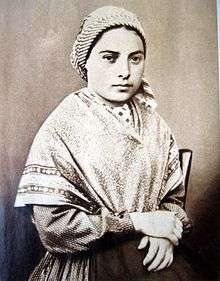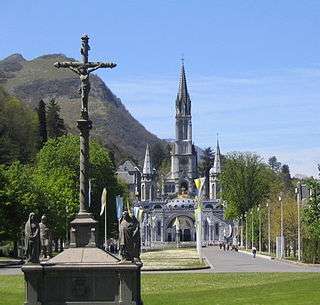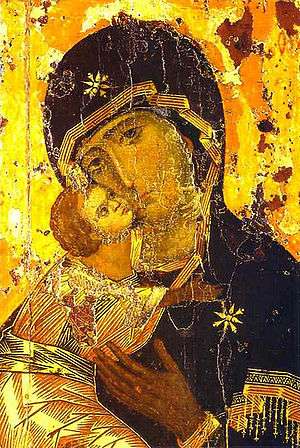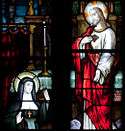Our Lady of Lourdes
| Our Lady of Lourdes Our Lady of the Immaculate Conception | |
|---|---|
|
The rock cave at Massabielle in Lourdes, where Saint Bernadette Soubirous said that she had seen the Blessed Virgin Mary. Now a religious grotto. | |
| Location | Lourdes, France |
| Date | 11 February 1858 |
| Witness | Saint Bernadette Soubirous |
| Type | Marian apparition |
| Holy See approval | 3 July 1876, during the pontificate of Pope Pius IX |
| Shrine | Sanctuary of Our Lady of Lourdes, Lourdes, France |
| Patronage | Lourdes, France, Tagaytay City of Cavite, Barangay Granada of Bacolod City, Tennessee, Diocese of Lancaster, bodily ills, sick people, protection from diseases |
Our Lady of Lourdes is a Roman Catholic title of the Blessed Virgin Mary venerated in honor of the Marian apparitions that reportedly occurred in 1858 in the vicinity of Lourdes in France. The first of these is the apparition of 11 February 1858, when Bernadette Soubirous, a 14-year-old peasant girl, told her mother that a "lady" spoke to her in the cave of Massabielle (a mile from the town) while she was gathering firewood with her sister and a friend.[1] Similar apparitions of the alleged "Lady" were reported on seventeen occasions that year, until the climax revelation of Our Lady of the Immaculate Conception took place.[2]
In 1862, Pope Pius IX authorized Bishop Bertrand-Sévère Laurence to permit the veneration of the Blessed Virgin Mary in Lourdes. On 3 July 1876, the same Pontiff officially granted a Canonical Coronation to the image that used to be in the courtyard of what is now part of the Rosary Basilica.[3][4] The image of Our Lady of Lourdes has been widely copied and reproduced, often displayed in shrines and homes, often in garden landscapes. Soubirous was later canonized as a Catholic saint.
History
Bernadette Soubirous
In 1858, Bernadette Soubirous reported a vision of Our Lady of Lourdes.[5][6] A simple 14-year-old peasant girl of no significant educational experience, Soubirous claimed she saw uo petito damizelo, "a small maiden,"[7] in white, with a golden rosary and blue belt fastened around her waist, and two golden roses at her feet. In subsequent visitations she heard the lady speak to her, saying Que soy era Immaculada Concepciou (I am the Immaculate Conception), and asking that a chapel be built there. At first ridiculed, questioned, and belittled by Church officials and other contemporaries, Soubirous insisted on her vision. Eventually the Church believed her and she was canonized by Pope Pius XI in 1933.[8][9]
After church investigations confirmed her visions, a large church was built at the site.[10] Lourdes is now a major Marian pilgrimage site: within France, only Paris has more hotels than Lourdes.
Apparition
On 11 February 1858, Soubirous went with her sister Toinette and Jeanne Abadie to collect some firewood and bones in order to buy some bread. After taking off her shoes and stockings to wade through the water near the Grotto of Massabielle, she said she heard the sound of two gusts of wind (coups de vent) but the trees and bushes nearby did not move. A wild rose in a natural niche in the grotto, however, did move.
I came back towards the grotto and started taking off my stockings. I had hardly taken off the first stocking when I heard a sound like a gust of wind. Then I turned my head towards the meadow. I saw the trees quite still: I went on taking off my stockings. I heard the same sound again. As I raised my head to look at the grotto, I saw a lady dressed in white, wearing a white dress, a blue girdle and a yellow rose on each foot, the same color as the chain of her rosary; the beads of the rosary were white....From the niche, or rather the dark alcove behind it, came a dazzling light.[11]
Soubirous tried to make the sign of the Cross but she could not, because her hands were trembling. The lady smiled, and invited Soubirous to pray the rosary with her.[12] Soubirous tried to keep this a secret, but Toinette told her mother. After parental cross-examination, she and her sister received corporal punishment for their story.[13]
Three days later, 14 February, Soubirous returned to the Grotto. She had brought holy water as a test that the apparition was not of evil origin/provenance: "The second time was the following Sunday. ... Then I started to throw holy water in her direction, and at the same time I said that if she came from God she was to stay, but if not, she must go. She started to smile, and bowed ... This was the second time."[14]
Soubirous's companions are said to have become afraid when they saw her in ecstasy. She remained ecstatic even as they returned to the village. On 18 February, she spoke of being told by the Lady to return to the Grotto over a period of two weeks. She quoted the apparition: "The Lady only spoke to me the third time. ... She told me also that she did not promise to make me happy in this world, but in the next."[13]
Soubirous was ordered by her parents to never go there again. She went anyway, and on 24 February, Soubirous related that the apparition asked for prayer and penitence for the conversion of sinners.
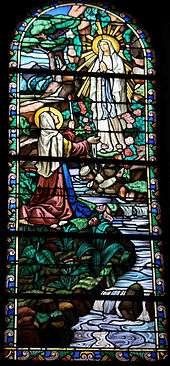
The next day, she said the apparition asked her to dig in the ground and drink from the spring she found there. This made her dishevelled and some of her supporters were dismayed, but this act revealed the stream that soon became a focal point for pilgrimages.[15] Although it was muddy at first, the stream became increasingly clean. As word spread, this water was given to medical patients of all kinds, and many reports of miraculous cures followed. Seven of these cures were confirmed as lacking any medical explanations by Professor Verges in 1860. The first person with a "certified miracle" was a woman whose right hand had been deformed as a consequence of an accident. Several miracles turned out to be short-term improvement or even hoaxes, and Church and government officials became increasingly concerned.[16] The government fenced off the Grotto and issued stiff penalties for anybody trying to get near the off-limits area. In the process, Lourdes became a national issue in France, resulting in the intervention of Emperor Napoleon III with an order to reopen the grotto on 4 October 1858. The Church had decided to stay away from the controversy altogether.
Soubirous, knowing the local area well, managed to visit the barricaded grotto under cover of darkness. There, on 25 March, she said she was told: "I am the Immaculate Conception" ("que soy era immaculada concepciou"). On Easter Sunday, 7 April, her examining doctor stated that Soubirous, in ecstasy, was observed to have held her hands over a lit candle without sustaining harm. On 16 July, Soubirous went for the last time to the Grotto. "I have never seen her so beautiful before," she reported.[16]
The Church, faced with nationwide questions, decided to institute an investigative commission on 17 November 1858. On 18 January 1860, the local bishop finally declared that: "The Virgin Mary did appear indeed to Bernadette Soubirous."[16] These events established the Marian veneration in Lourdes, which together with Fátima, is one of the most frequented Marian shrines in the world, and to which between 4 and 6 million pilgrims travel annually.
In 1863, Joseph-Hugues Fabisch was charged to create a statue of the Virgin according to Soubirous's description. The work was placed in the grotto and solemnly dedicated on 4 April 1864 in presence of 20,000 pilgrims.
Soubirous was later canonized as a saint in 1933.
The veracity of the apparitions of Lourdes is not an article of faith for Catholics. Nevertheless, all recent Popes visited the Marian shrine at some time. Benedict XV, Pius XI, and John XXIII went there as bishops, Pius XII as papal delegate. He also issued an encyclical, Le pèlerinage de Lourdes, on the one-hundredth anniversary of the apparitions in 1958. John Paul II visited Lourdes three times during his Pontificate, and twice before as a Bishop.
Historical context
Many Marian apparitions, although they may occur in different ages and cultures, share similarities. Soubirous's visions took place against a cultural backdrop of apparitions and other supernatural events that bear some resemblance to Soubirous's experiences. It is likely that Soubirous would have known of, and may even have been influenced by, such events, which were woven into the fabric of her society.
In nearby Lestelle-Bétharram, only a few kilometres from Lourdes, some shepherds guarding their flocks in the mountains observed a vision of a ray of light that guided them to the discovery of a statue of the Virgin Mary. Two attempts were made to remove the statue to a more prominent position; each time it disappeared and returned to its original location, at which a small chapel was built for it.[17]
In the early sixteenth century, a twelve-year-old shepherdess called Anglèze de Sagazan received a vision of the Virgin Mary near the spring at Garaison (part of the commune of Monléon-Magnoac), somewhat further away. Anglèze's story is strikingly similar to that of Soubirous: she was a pious but illiterate and poorly educated girl, extremely impoverished, who spoke only in the local language, Gascon Occitan, but successfully convinced authorities that her vision was genuine and persuaded them to obey the instructions of her apparitions. Like Soubirous, she was the only one who could see the apparition (others could apparently hear it); however, the apparition at Garaison's supernatural powers tended toward the miraculous provision of abundant food, rather than healing the sick and injured. Mid-nineteenth century commentators noted the parallels between the events at Massabielle and Garaison, and interestingly, interpreted the similarities as proof of the divine nature of Soubirous's claims.[18] At the time of Soubirous, Garaison was a noted center of pilgrimage and Marian devotion.
There are also several similarities between the apparition at La Salette, near Grenoble, and Lourdes. La Salette is many hundreds of kilometres from Lourdes, and the events at La Salette predate those in Lourdes by 12 years. However, Virgin Mary's appearance of La Salette was tall and maternal (not petite and gentle like her Lourdes apparition) and had a darker, more threatening series of messages. It is not certain if Soubirous was aware of the events at La Salette.[19]
Position of the Catholic Church

Approval of Lourdes
On 18 January 1862, Bishop Laurence, the Bishop of Tarbes, declared: "We are inspired by the Commission comprising wise, holy, learned and experienced priests who questioned the child, studied the facts, examined everything and weighed all the evidence. We have also called on science, and we remain convinced that the Apparitions are supernatural and divine, and that by consequence, what Soubirous saw was the Most Blessed Virgin. Our convictions are based on the testimony of Soubirous, but above all on the things that have happened, things which can be nothing other than divine intervention".[20]
Nature of approval
Because the apparitions are private, and not public revelations, Catholics are not required to believe them. They do not add any additional material to the truths of the Catholic Church as expressed in public revelation. Soubirous said, "One must have faith and pray; the water will have no virtue without faith."
Holy Mass of Our Lady of Lourdes
The Catholic Church celebrates a mass in honor of "Our Lady of Lourdes" (optional memorial) in many countries on February 11 of each year — the anniversary of the first apparition. There had long been a tradition of interpreting the Song of Songs as an allegory of God's love for the Church, so up until the liturgical reforms following Vatican II, a passage from this Old Testament book was used during the mass for its reference to the "beloved" appearing in a cleft of a rock[21] and its parallel with what Catholics have described as the "Mother of the Church"[22] being seen in the cleft of a rock in Lourdes.
Popes and Lourdes

Pope Pius IX approved the veneration in Lourdes and supported the building of the Cathedral in 1870 to which he donated several gifts. He approved the veneration and promoted Marian piety in Lourdes with the granting of special indulgences and the formation of local Lourdes associations.[23] Pope Leo XIII crowned Our Lady of La Salette and issued an apostolic letter Parte Humanae Generi in commemoration of the consecration of the new Cathedral in Lourdes in 1879.[24] Pope Benedict XV, when archbishop of Bologna, organized a diocesan pilgrimage to Lourdes, asking for the veneration of the Immaculate Virgin there. In 1907, Pope Pius X introduced the feast of the apparition of the Immaculate Virgin of Lourdes. In the same year he issued his encyclical Pascendi dominici gregis, in which he specifically repeated the permission to venerate the virgin in Lourdes.[25]
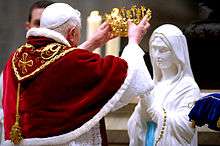
In 1937, Pius XI nominated Eugenio Pacelli as his 'Papal Delegate' to personally visit and venerate in Lourdes. Pius XI beatified Soubirous on 6 June 1925. He canonized her on the Feast of the Immaculate Conception on 8 December 1933 and determined her Feast Day to be 18 February. Soubirous, who suffered from asthma and bone cancer, had lived on the borderline of social acceptance in the church during her lifetime.[26] The Virgin Mary reportedly told Soubirous 'that she did not promise to make me happy in this world, but in the next.'[27]
Pope Pius XII, commemorating the hundredth anniversary of the Immaculate conception dogma, announced a Marian year, the first one on Church history. In his encyclical Fulgens corona, he described the events in Lourdes:
It seems that the Blessed Virgin Mary herself wished to confirm by some special sign the definition, which the Vicar of her Divine Son on earth had pronounced amidst the applause of the whole Church. For indeed four years had not yet elapsed when, in a French town at the foot of the Pyrenees, the Virgin Mother, youthful and benign in appearance, clothed in a shining white garment, covered with a white mantle and girded with a hanging blue cord, showed herself to a simple and innocent girl at the grotto of Massabielle. And to this same girl, earnestly inquiring the name of her with whose vision she was favored, with eyes raised to heaven and sweetly smiling, she replied: "I am the Immaculate Conception." [28]

Le pèlerinage de Lourdes, the only encyclical written on Lourdes, was issued on the centenary of the apparitions at Lourdes. The encyclical represents one of the strongest pronouncements of the papal magisterium on Marian apparitions in the history of the Catholic Church. The Pope presents Mary as the model of alternative lifestyle. The school of Mary teaches selflessness and charity.
In the school of Mary one can learn to live, not only to give Christ to the world, but also to await with faith the hour of Jesus, and to remain with Mary at the foot of the cross. Wherever providence has placed a person, there is always more to be done for God's cause. Priests should with supernatural confidence, show the narrow road which leads to life. Consecrated and Religious fight under Mary's banner against inordinate lust for freedom, riches, and pleasures. In response to the Immaculate, they will fight with the weapons of prayer and penance and by triumphs of charity. Go to her, you who are crushed by material misery, defenseless against the hardships of life and the indifference of men. Go to her, you who are assailed by sorrows and moral trials. Go to her, beloved invalids and infirm, you who are sincerely welcomed and honoured at Lourdes as the suffering members of our Lord. Go to her and receive peace of heart, strength for your daily duties, joy for the sacrifice you offer.[29][30]
The Basilica of St. Pius X was consecrated on 25 March 1958, by the Patriarch of Venice, cardinal Angelo Roncalli, the future Pope John XXIII. Giovanni Battista Montini, the future Pope Paul VI, had visited Lourdes as archbishop of Milan. Pope John Paul II undertook three pilgrimages to Lourdes, the last one shortly before his death. Pope Benedict XVI visited Lourdes commemorating the 150th anniversary of the apparitions in September 2008. Born on Soubirous' feast day 16 April in 1927, three days after his 78th birthday the then-Cardinal Joseph Ratzinger was elected to the See of Peter on 19 April 2005 in a papal conclave and celebrated his Papal Inauguration Mass on 24 April 2005.
Lourdes water
The location of the spring was described to Soubirous by an apparition of Our Lady of Lourdes on 25 February 1858. Since that time many thousands of pilgrims to Lourdes have followed the instruction of Our Lady of Lourdes to "drink at the spring and wash in it".
Although never formally encouraged by the Church, Lourdes water has become a focus of devotion to the Virgin Mary at Lourdes. Since the apparitions, many people have claimed to have been cured by drinking or bathing in it,[31] and the Lourdes authorities provide it free of charge to any who ask for it.[32]
An analysis of the water was commissioned by Mayor Anselme Lacadé of Lourdes in 1858. It was conducted by a professor in Toulouse, who determined that the water was potable and that it contained the following: oxygen, nitrogen, carbonic acid, carbonates of lime and magnesia, a trace of carbonate of iron, an alkaline carbonate or silicate, chlorides of potassium and sodium, traces of sulphates of potassium and soda, traces of ammonia, and traces of iodine.[33] Essentially, the water is quite pure and inert. Lacadé had hoped that Lourdes water might have special mineral properties which would allow him to develop Lourdes into a spa town, to compete with neighbouring Cauterets and Bagnères-de-Bigorre.[31]
Secular views
Historical, psychological, natural analogies and other empirical explanations have been forwarded, all of which are welcomed by the Catholic Church, provided they are generally open-ended and unbiased.[34] Analogies are most common in Marian apparitions, they indicate that the person involved used popular images and common language. They do not by themselves support arguments for or against the apparition itself.
Thus, Soubirous described the apparition as uo petito damizelo ("a tiny maiden") of about twelve years old. Soubirous insisted that the apparition was no taller than herself. At 1.40 metres (4 ft 7 in) tall, Soubirous was diminutive even by the standards of other poorly nourished children.[35]
Soubirous described that the apparition as dressed in a flowing white robe, with a blue sash around her waist. This was the uniform of a religious group called the Children of Mary, which, on account of her poverty, Soubirous was not permitted to join (although she was admitted after the apparitions).[36] Her Aunt Bernarde was a long-time member.
The statue that currently stands in the niche within the grotto of Massabielle was created by the Lyonnais sculptor Joseph-Hugues Fabisch in 1864. Although it has become an iconographic symbol of Our Lady of Lourdes, it depicts a figure which is not only older and taller than Soubirous's description, but also more in keeping with orthodox and traditional representations of the Virgin Mary. On seeing the statue, Soubirous was profoundly disappointed with this representation of her vision.[37]
The Sanctuary
The Sanctuary of Our Lady of Lourdes or the Domain (as it is most commonly known) is an area of ground surrounding the shrine (Grotto) to Our Lady of Lourdes in the town of Lourdes, France. This ground is owned and administrated by the Church, and has several functions, including devotional activities, offices, and accommodation for sick pilgrims and their helpers. The Domain includes the Grotto itself, the nearby taps which dispense the Lourdes water, and the offices of the Lourdes Medical Bureau, as well as several churches and basilicas. It comprises an area of 51 hectares, and includes 22 separate places of worship.[38] There are six official languages of the Sanctuary: French, English, Italian, Spanish, Dutch and German.
Affiliate and replica shrines
- The Church of Notre Dame (New York City) is an affiliated Church of Our Lady of Lourdes. It is dedicated to her veneration and Lourdes waters are available to pilgrims at the New York church, with the 1910 interior constructed as a faithful, large-scale replica of the Grotto.
- Scotland's Carfin Grotto includes a replica of Our Lady of Lourdes.
- Mount Saint Mary's University, Emmitsburg, MD National Shrine Grotto of Our Lady of Lourdes.
The Lourdes Medical Bureau
To ensure claims of cures were examined properly and to protect the town from fraudulent claims of miracles, the Lourdes Medical Bureau (Bureau Medical) was established at the request of Pope Saint Pius X. It is completely under medical rather than ecclesiastical supervision. Approximately 7000 people have sought to have their case confirmed as a miracle, of which 68 have been declared a scientifically inexplicable miracle by both the Bureau and the Catholic Church.[39]
The officially recognized miracle cures in Lourdes are among the least controversial in the Catholic world, because Lourdes from the very beginning was subject to intense medical investigation from skeptical doctors around the world. All medical doctors with the appropriate specialization in the area of the cure have unlimited access to the files and documents of the Lourdes Medical Bureau (Bureau Medical),[40] which also contains all approved and disapproved miracles. Most officially recognized cures in Lourdes were openly discussed and reported on in the media at the time. Nevertheless, there were a few instances where medically ascertained incomprehension turned out not to be miracles, because the illness reappeared in later years. In the vast number of cases however, the judgment of the medical and ecclesiastical authorities was upheld as beyond medical explanation in later critical investigations.[41]
Pilgrimages
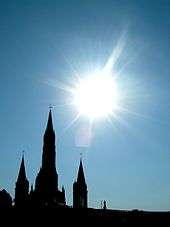
The pilgrimage site is visited by millions of Catholics each year, and Lourdes has become one of the prominent pilgrimage sites of the world. Miraculous healings have been claimed, and a number of these have been documented by the Lourdes Medical Commission. Large numbers of sick pilgrims travel to Lourdes each year in the hope of physical healing or spiritual renewal.
In popular culture
- In 1939, Henry K. Dunn directed Miracle at Lourdes for MGM's Miniature series. It is a short film about a terminally ill woman who hopes to be healed at the shrine.
- In 1943, the events became the basis of the film The Song of Bernadette. Jennifer Jones played the title role while Linda Darnell portrayed the Virgin Mary. The film won several Academy Awards, including an Academy Award for Best Actress for Jones.[42]
- In 1959, singer Andy Williams recorded a song entitled The Village of St. Bernadette.[43]
- Also in 1959, Loretta Young filmed The Road, an episode of her popular television show, in Lourdes.
- Aaron Neville and Linda Ronstadt performed a duet version of the Leonard Cohen song Song of Bernadette in concert in New Orleans.
- In 2009 Jessica Hausner wrote and directed the French feature film Lourdes starring Sylvie Testud. The fictional drama tells the story of wheelchair-bound Christine, who in order to escape her isolation, makes a life changing journey to Lourdes, the iconic site of pilgrimage in the Pyrenees.[44]
- In 2015–16, singer-songwriter Michael Knott recorded a song entitled Lady of Lourdes.[45]
See also
Notes
- ↑ The event was not a rite of Canonical coronation, nor a re-coronation of the image at the Rosary basilica.
References
Citations
- ↑ Catholic Online: Apparitions of Our Lady of Lourdes First Apparition Archived April 12, 2005, at the Wayback Machine.
- ↑ "2009 Catholic Almanac". Our Sunday Visitor Publishing.
- ↑ "La Vierge Courinnee", Sanctuaire Notre-Dame du Lourdes
- ↑ "Marie Reine, 22 août", Zenit, 21 Août 2013
- ↑ Stravinskas, Peter. What Mary Means to Christians: An Ancient Tradition Explained, 2012, Paulist Press ISBN 0809147440 chapter on "Lourdes, Fatima, Guadalupe"
- ↑ Bunson, Matthew. The Catholic Almanac's Guide to the Church, 2001 ISBN 0879739142 p. 194
- ↑ Blanton, Margaret Grey, Bernadette of Lourdes. Longmans, Green & Co., 1939.
- ↑ Burke, Raymond L.; et al. (2008). Mariology: A Guide for Priests, Deacons, Seminarians, and Consecrated Persons ISBN 978-1-57918-355-4 pp. 850-868
- ↑ Lauretin, R., Lourdes, Dossier des documents authentiques, Paris: 1957
- ↑ Buckley, James; Bauerschmidt, Frederick Christian, and Pomplun, Trent. The Blackwell Companion to Catholicism, 2010 ISBN 1444337327 p. 317
- ↑ Taylor, Thérèse (2003). Bernadette of Lourdes. Burns and Oates. ISBN 0-86012-337-5
- ↑ Fr. Paolo O. Pirlo, SHMI (1997). "Our Lady of Lourdes". My First Book of Saints. Sons of Holy Mary Immaculate - Quality Catholic Publications. pp. 49–50. ISBN 971-91595-4-5.
- 1 2 Laurentin 1988, p. 161.
- ↑ Harris 1999, p. 4.
- ↑ Harris 1999, p. 7.
- 1 2 3 Lauretin 1988, p. 162.
- ↑ Harris 1999, p. 39.
- ↑ Harris 1999, p. 41.
- ↑ Harris 1999, p. 60.
- ↑ "Lourdes France: The encounters with the Blessed Virgin Mary", Sanctuaire Notre-Dame du Lourdes
- ↑ "Song of Songs", 2:14, retrieved 29 May 2007
- ↑ "Mary, Mother of Christ, Mother of the Church", Catechism of the Catholic Church 963, retrieved 29 May 2007.Vatican.va
- ↑ Schmidlin, Josef.Papstgeschichte, München 1934, 317
- ↑ Bäumer Leo XIII, Marienlexikon, 97
- ↑ Bäumer, Pius X Marienlexikon, 246
- ↑ Hahn Baier, Bernadette Soubirous, Marienlexikon, 217
- ↑ Catholic Pilgrims: Apparitions at Lourdes
- ↑ Fulgens Corona, §3
- ↑ Le pèlerinage de Lourdes, 57
- ↑ Le pèlerinage de Lourdes, 40 ff
- 1 2 Harris, Ruth. Lourdes: Body and Spirit in the Secular Age, Penguin Books, 2000, p. 312.
- ↑ Clarke, Richard. 2008 Lourdes, Its Inhabitants, Its Pilgrims, And Its Miracles ISBN 1-4086-8541-8 p. 38
- ↑ Barbé, Daniel. Lourdes
- ↑ Stöger, Erscheinungen in Marienlexikon, 395 ff
- ↑ Harris 1999, p. 72.
- ↑ Harris 1999, p. 43.
- ↑ Visentin, M.C. (2000). "María Bernarda Soubirous (Bernardita)". In Leonardi, C.; Riccardi, A.; Zarri, G. Diccionario de los Santos (in Spanish). Spain: San Pablo. pp. 1586–1596. ISBN 84-285-2259-6.
- ↑ Sanctuaire Notre-Dame du Lourdes
- ↑ Where Scientists are looking for God, The Telegraph, 16 January 2002. Retrieved 7 August 2012
- ↑ Müller, 767
- ↑ Müller 768
- ↑ "NY Times: The Song of Bernadette". NY Times. Retrieved 2008-12-15.
- ↑ Andy Williams, "The Village of St. Bernadette" chart positions Retrieved June 6, 2013
- ↑ Hausner's Lourdes wins Viennale best film award. Screen daily.com, 4 November 2009.
- ↑ Michael Knott - Songs From The Feather River Highway EP. Knottheads.com, Retrieved June 4, 2016
Works cited
- Glynn, Paul (2003). Healing Fire of Christ: Reflections on Modern Miracles. Ignatius Press.
- Harris, Ruth (1999). Lourdes: 0irit in the Secular Age. Penguin Books. ISBN 0-71-399186-0.
- Laurentin, L. (1988). "Lourdes". Marienlexikon. Regensburg: Eos Verlag.
- Marnham, Patrick (1982). Lourdes, A Modern Pilgrimage. Image Books.
External links
- Cures and miracles - An overview by the official website of the shrine. This site also offers containers of Lourdes Spring water straight from the source.
- Pilgrimage of His Holiness John Paul II to Lourdes on the Occasion of the 150th Anniversary of the Promulgation of the Dogma of the Immaculate Conception.
